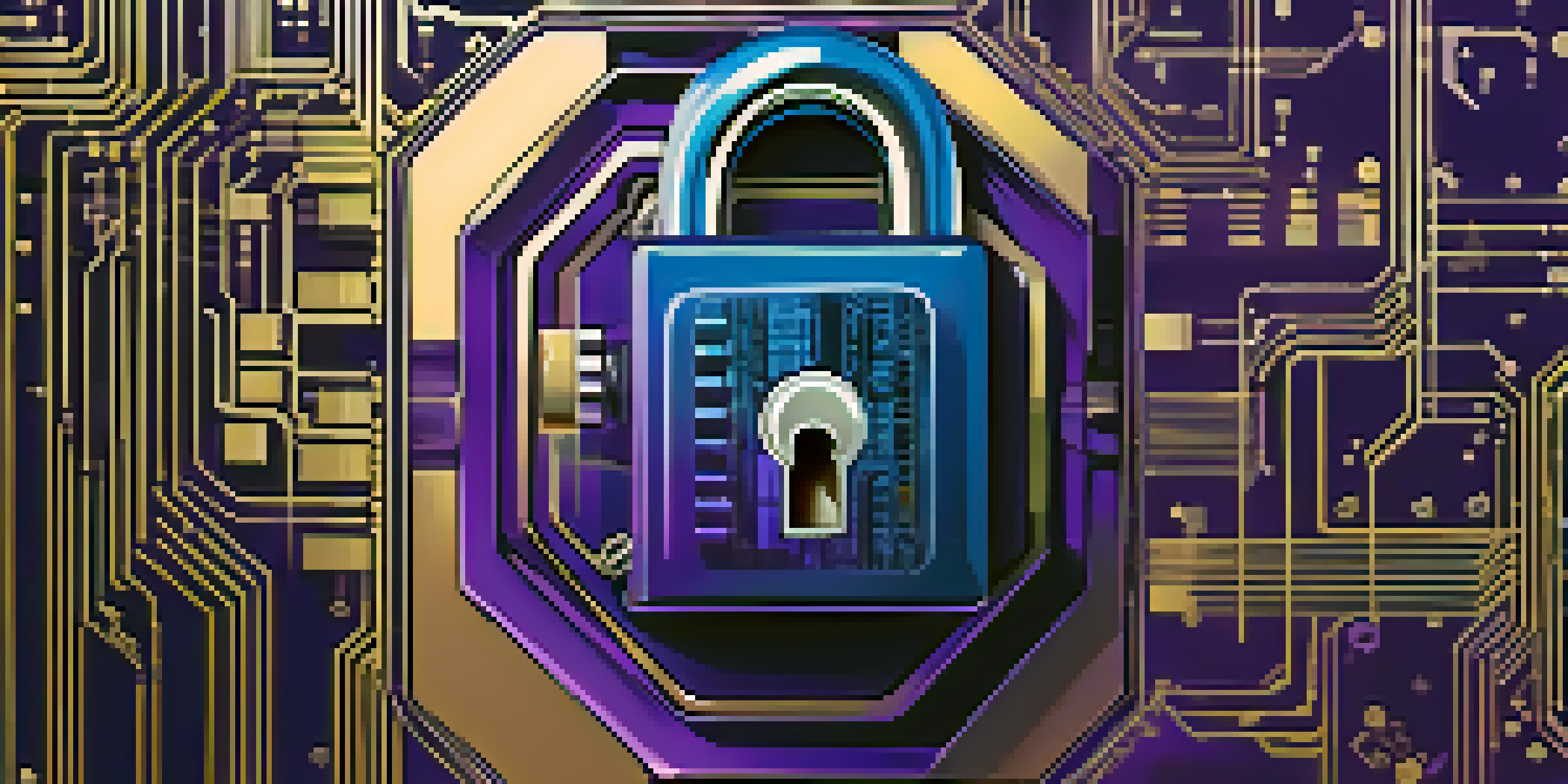Key Technologies Behind Digital Rights Management Systems

Understanding Digital Rights Management (DRM)
Digital Rights Management (DRM) refers to a collection of technologies that control the use of digital content. It serves as a protective barrier against unauthorized access and distribution, ensuring that creators receive due credit and compensation for their work. Think of DRM as a digital lock on a door, allowing only authorized individuals to enter.
Intellectual property is the oil of the 21st century.
The primary goal of DRM is to safeguard intellectual property, especially in industries like music, film, and publishing. Without such measures, content could be easily copied and shared, undermining the financial viability of creative enterprises. This highlights the importance of implementing robust DRM systems to protect valuable content.
While DRM technologies can be controversial, particularly regarding consumer rights, they play a crucial role in maintaining the balance between access and protection. It's essential for creators to utilize these tools effectively to foster a sustainable digital ecosystem.
Encryption: The Backbone of DRM Security
Encryption is one of the cornerstone technologies behind effective DRM systems. It transforms content into a format that can only be accessed by those who possess the correct decryption key, much like a secret code. This ensures that even if data is intercepted, it remains unreadable to unauthorized users.

There are various encryption algorithms employed in DRM, such as AES (Advanced Encryption Standard) and RSA (Rivest-Shamir-Adleman). These algorithms differ in complexity and use cases, but all serve the common purpose of protecting digital content. By implementing strong encryption, content providers can instill confidence in their users about the security of their intellectual property.
DRM Protects Digital Content
Digital Rights Management (DRM) technologies safeguard creators' intellectual property from unauthorized access and distribution.
However, encryption alone is not a silver bullet. It must be coupled with other technologies to form a comprehensive DRM strategy that addresses various threats and vulnerabilities in the digital landscape.
Watermarking: A Unique Identifier for Content
Watermarking is another crucial technology used in DRM systems to track and identify digital content. This technique involves embedding a unique identifier or code into the content, which can be invisible or visible, depending on the application. Think of it as a digital signature that marks ownership while not interfering with the user experience.
The internet is the first thing that humanity has built that humanity doesn't understand, the largest experiment in anarchy that we have ever had.
The primary advantage of watermarking is its ability to trace unauthorized copies back to the source, which can deter piracy. For example, if a movie is leaked online, watermarking can help identify the original distributor, making it easier to take legal action. This proactive approach can significantly reduce the risk of content theft.
Moreover, watermarking can also enhance user engagement by enabling personalized experiences. For instance, a streaming service could use watermarked content to offer tailored recommendations based on a user's viewing history.
Authentication: Verifying User Identity
Authentication is a vital component of DRM systems that ensures only authorized users can access protected content. It involves verifying a user's identity through various methods, such as passwords, biometric data, or security tokens. This step acts as the gatekeeper, controlling who gets in and who doesn't.
With the rise of cloud-based services, authentication methods have evolved to include multi-factor authentication (MFA), which adds an extra layer of security. For example, a user may need to enter a password and confirm their identity through a text message or email. This approach significantly reduces the risk of unauthorized access and enhances overall security.
Encryption Ensures Security
Encryption is a key component of DRM that secures digital content by converting it into formats accessible only to authorized users.
Effective authentication not only protects content but also builds trust between users and providers. When users feel secure about their access, they are more likely to engage and invest in digital content.
License Management: Controlling Content Usage
License management is a key technology that allows content providers to define how their digital assets can be used. It involves creating and enforcing licenses that outline the terms of access, such as the duration of use or the number of devices allowed. This is akin to a rental agreement for digital media.
By implementing effective license management, providers can monetize their content more effectively and ensure compliance with their terms. For instance, a music streaming platform may allow subscribers to download songs for offline use but restrict sharing them with others. This flexibility helps cater to user preferences while protecting the provider's interests.
Moreover, license management can facilitate a seamless user experience by automating renewals and notifications. This ensures that users remain informed about their access rights and can enjoy content without disruptions.
Content Distribution Networks (CDNs): Enhancing Access
Content Distribution Networks (CDNs) play an essential role in the delivery of digital content while incorporating DRM technologies. CDNs are networks of servers strategically located around the world that store and distribute content closer to users. This ensures faster loading times and improved accessibility for a global audience.
By integrating DRM with CDNs, content providers can deliver protected content efficiently while maintaining security. For example, a video streaming service can utilize a CDN to serve high-quality video streams while ensuring that only authorized users can access them through encryption and authentication measures.
User Experience Matters
Balancing security with user experience is essential for effective DRM systems, enabling easy access while maintaining protection.
In addition to improving access, CDNs can also provide valuable analytics to content providers. This data can inform strategies for optimizing content delivery and enhancing user experiences, ultimately leading to higher engagement and satisfaction.
User Experience: Balancing Security and Accessibility
While security is paramount in DRM systems, user experience should not be overlooked. A seamless and intuitive experience encourages users to engage with digital content without feeling frustrated by overly complex security measures. Striking this balance is crucial for the long-term success of any DRM strategy.
For instance, using single sign-on (SSO) solutions can simplify the authentication process, enabling users to access multiple platforms with a single login. This not only enhances convenience but also maintains security standards. Users are more likely to appreciate the ease of access when they do not have to remember numerous passwords.

Ultimately, an effective DRM system should provide a secure environment while ensuring users can enjoy content with minimal hassle. This approach fosters positive relationships between content providers and users, leading to greater loyalty and retention.
The Future of DRM Technologies
As technology continues to evolve, so too will DRM systems. Emerging technologies like blockchain and artificial intelligence (AI) are poised to reshape how digital rights are managed and enforced. For instance, blockchain can offer transparent and tamper-proof records of ownership, while AI can help identify potential security threats in real-time.
Additionally, as user expectations shift towards greater accessibility and flexibility, DRM solutions will need to adapt. This may involve more personalized licensing options or enhanced interoperability across platforms, allowing users to access their content seamlessly. Staying ahead of these trends will be crucial for content providers.
In conclusion, the future of DRM technologies holds immense potential for both creators and consumers. By embracing innovation and prioritizing user experience, stakeholders can create a sustainable digital landscape that supports creativity while protecting intellectual property.